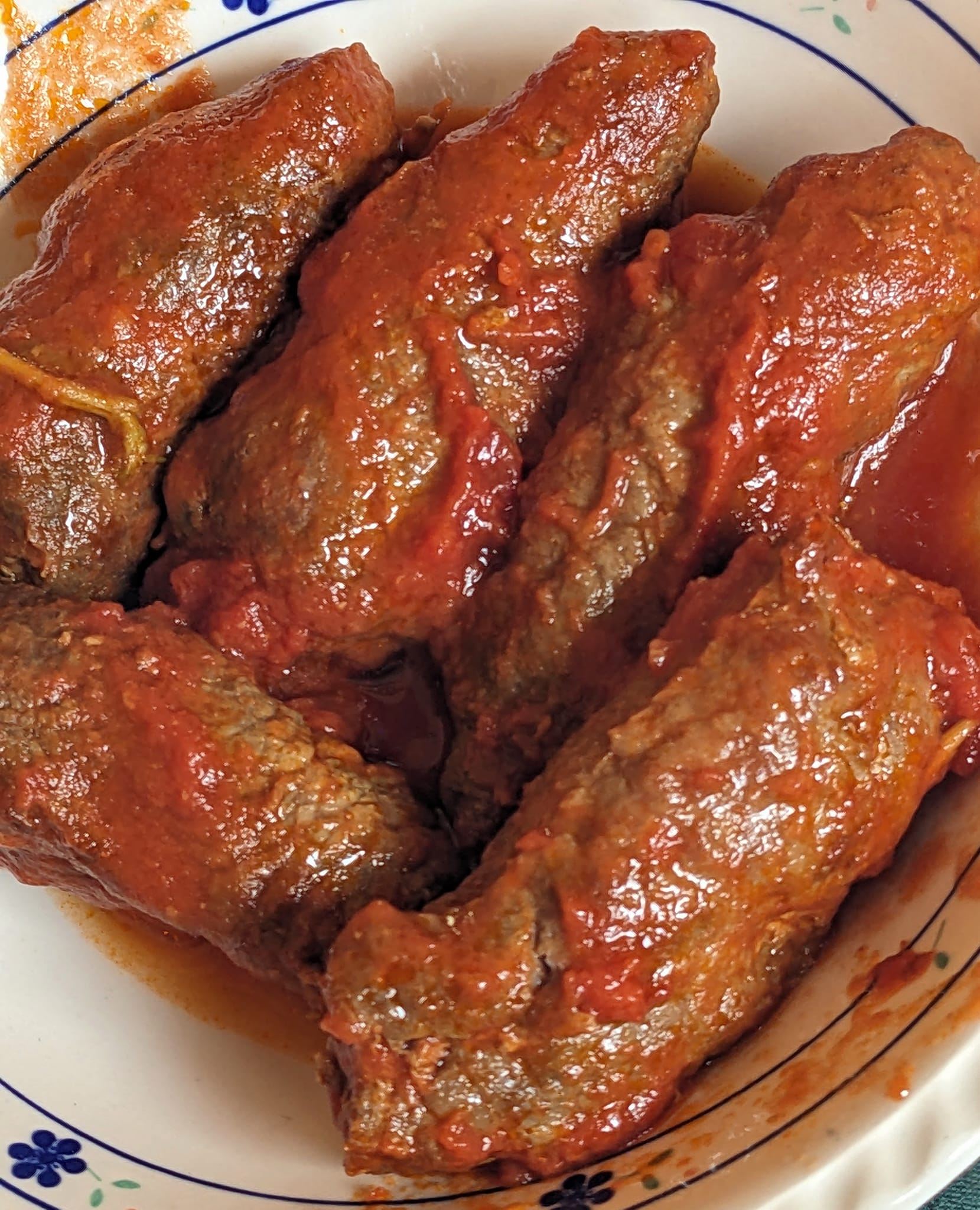Braciole al Sugo is the epitome of Italian comfort — a soulful dish that celebrates slow cooking, simple ingredients, and deep, rustic flavor.
Thin slices of tender beef are filled with salty prosciutto, fragrant garlic, parsley, and sharp pecorino, then rolled, seared, and simmered for hours in a rich tomato sauce. The result is melt-in-your-mouth beef infused with all the essence of the sugo, creating a meal that feels both elegant and homely.
This dish is the kind of Sunday tradition that gathers families around the table — the sauce coating a plate of pasta for the first course, and the braciole itself served as the hearty second. It’s old-world Italian cooking at its best: slow, generous, and full of love.

Why People Will Love This Braciole al Sugorecipe
Authentic Italian comfort: Braciole al Sugo embodies the heart of traditional Italian home cooking — rich, slow-simmered, and full of love in every bite.
Tender, flavorful meat: The beef becomes incredibly soft as it slowly cooks in tomato sauce, soaking up all the flavors of garlic, basil, and prosciutto.
Perfectly layered flavors: Each bite delivers a balance of savory prosciutto, sharp pecorino, fragrant herbs, and the tangy sweetness of tomato sauce.
Versatile and elegant: This dish works beautifully for both family Sunday dinners and special occasions, offering sophistication without being fussy.
Two meals in one: Italians traditionally serve the sauce over pasta as a first course, then enjoy the stuffed beef rolls as the main — a complete and comforting feast.
Timeless culinary heritage: Cooking Braciole al Sugo connects you to generations of Italian tradition — slow food, simple ingredients, and soulful dining.
Key Ingredients
Beef (top or bottom round): The foundation of this dish — thinly sliced and gently pounded to tenderness, ready to absorb the rich flavors of the sauce as it simmers.
Prosciutto: Adds a salty, savory depth inside each roll, infusing the meat with umami richness as it cooks.
Pecorino cheese: A bold, aged cheese that melts slightly within the beef, giving every bite a sharp, nutty, and creamy touch.
Garlic and fresh parsley: These aromatic essentials bring freshness and warmth, tying the flavors together in true Italian fashion.
Tomato passata: The heart of the sugo — smooth, vibrant, and rich — it transforms into a luscious sauce that envelops the braciole.
Olive oil and basil: Classic Italian finishing touches that add fruitiness, fragrance, and the unmistakable soul of Mediterranean cooking.
Expert Tips
Choose the right cut of beef: Opt for top or bottom round, sirloin, or silverside — cuts that are lean yet flavorful. Pound the meat thinly (about ¼ inch) for tender rolls that cook evenly and absorb the sauce beautifully.
Layer thoughtfully: When assembling, balance the saltiness of the prosciutto and pecorino with the freshness of parsley and garlic. A light touch is key — overstuffing can make rolling difficult and cause fillings to leak during cooking.
Secure the rolls properly: Use toothpicks or kitchen twine to hold each braciola firmly in place. This prevents the filling from escaping and ensures the meat maintains its shape throughout the long simmer.
Brown for flavor: Take the time to sear the braciole on all sides before adding the tomato sauce. This caramelization step develops deep, meaty flavor and adds richness to the final dish.
Slow simmer for tenderness: True Italian braciole requires patience. Let the rolls cook low and slow for at least 2 hours — this allows the connective tissues to break down, the flavors to meld, and the sauce to thicken into a velvety finish.
Rest before serving: Allow the braciole to rest for a few minutes after cooking. This helps the juices redistribute, keeping the meat moist and flavorful when sliced.
Don’t waste the sauce: The sugo from the braciole is gold — use it to toss with pasta for the first course, as Italian families traditionally do, then serve the braciole as the second course for a complete, rustic meal.

Braciole Al Sugo
Ingredients
1.3 lbs top or bottom round beef roast can also use sirloin or silverside (600g)
8-10 slices prosciutto
2 garlic cloves finely chopped
2 tablespoon fresh parsley finely chopped
8-10 slices of pecorino cheese
3 cups crushed strained tomatoes passata
1 tablespoon fresh basil chopped
1 tablespoon olive oil
Instructions
Cut the beef into ¼ inch (½ cm) thick slices. Pound them to half the thickness with a meat mallet or rolling pin.
Sprinkle the inside of each slice of beef with a little salt and pepper then lay a slice of prosciutto on top.
Sprinkle over a small amount of garlic, parsley and place a slice of pecorino in the middle. Roll up the slice of beef and secure each end with a toothpick.
Heat the olive oil in a large pot and brown the braciole on all sides. Once browned add the strained tomatoes and stir to combine. Cover with a lid and turn the heat down to low, simmer slowly for 2 hours.
Once the braciole are cooked add the fresh basil to the sauce and stir to combine, serve.
How to serve it traditionally
Once cooked remove the beef braciole and set aside or keep warm on a plate. Add the fresh basil to the sauce and serve the sauce with freshly cooked and drained pasta then serve the beef braciole as a second course with a little reserved tomato sauce and your sides of choice.
Important Notes When Making Braciole Al Sugo
Meat preparation is crucial: Ensure the beef slices are evenly pounded to about ¼ inch thickness. This not only tenderizes the meat but also guarantees that the rolls cook uniformly and remain soft after simmering. Thick slices will stay tough, while uneven ones may cook inconsistently.
Control the salt levels: Both prosciutto and pecorino are naturally salty. Go easy on additional salt in the filling or sauce until after the final tasting. Adjust seasoning toward the end of cooking to maintain balance.
Use quality tomatoes: The richness of the sauce depends heavily on the passata or crushed tomatoes you choose. Opt for San Marzano or other high-quality Italian varieties for a sweeter, more authentic sugo flavor.
Brown before simmering: Don’t skip the browning step. This caramelizes the outer layer of the meat and builds deep flavor in both the braciole and the tomato sauce. Deglaze the pan with a splash of water or wine if needed to capture all those savory bits.
Simmer gently — never boil: Keep the sauce at a low, steady simmer. Boiling will toughen the meat and cause the sauce to separate. The slow simmer allows the beef to absorb the tomato, basil, and prosciutto essence, creating a luxurious, silky finish.
Check for doneness: The braciole should be tender enough to cut easily with a fork after about 2 hours. If the sauce thickens too much before the meat is done, add a small amount of water or broth to maintain the right consistency.
Serving tradition matters: For a true Italian experience, remove the braciole before serving the sauce with pasta, then return them for the second course. This honors the dish’s heritage and makes every element shine on its own.
Make ahead for deeper flavor: Braciole tastes even better the next day. Allowing it to rest overnight in the sauce enhances the harmony between the meat, herbs, and tomato, resulting in a richer and more cohesive dish when reheated.
How to Enjoy Braciole al Sugo After Cooking
Step 1: Let it Rest Before Serving
Once your Braciole al Sugo has finished simmering, allow it to rest in the sauce for about 10–15 minutes off the heat. This short resting period helps the juices redistribute throughout the beef, keeping it tender and moist while allowing the flavors to deepen further.
Step 2: Serve in the Traditional Italian Way
In true Italian fashion, this dish is served in two stages:
First course (Primo): Ladle the rich tomato sauce — the sugo — over freshly cooked pasta such as tagliatelle, rigatoni, or spaghetti. Toss to coat and top with grated pecorino or Parmesan cheese.
Second course (Secondo): Serve the tender beef rolls as the main course, drizzled with a spoonful of the same sauce. Add a side of crusty bread, roasted vegetables, or a light salad for a complete meal.
Step 3: Pair with the Right Wine
A robust red wine pairs beautifully with this hearty dish. Try a Chianti Classico, Barbera d’Asti, or Montepulciano d’Abruzzo — their acidity complements the tomato sauce while balancing the richness of the beef and prosciutto.
Step 4: Don’t Forget the Bread
Serve with a rustic loaf or Italian ciabatta to soak up every last drop of the flavorful sugo. Italians never let good sauce go to waste — it’s part of the joy of the meal.
Step 5: Enjoy Family-Style
Braciole al Sugo is a dish meant for sharing. Serve it straight from the pot or in a large serving dish at the center of the table. Let everyone cut into their own braciole, appreciating the swirl of prosciutto, cheese, herbs, and beef in every slice.
Step 6: Save the Leftovers (They Taste Even Better!)
Store any leftovers in the refrigerator overnight. The sauce continues to develop flavor as it sits, making the next day’s meal even more delicious. Gently reheat on the stove over low heat until warmed through — never microwave, as it can dry the meat.
Step 7: Finish with an Italian Touch
End your meal with a classic Italian dessert like tiramisu, panna cotta, or a simple espresso. This completes the authentic Italian dining experience and balances the richness of the Braciole al Sugo beautifully.
Nutrition Information:
Yields: 4 servings | per serving:
Calories: 420 kcal | Total Fat: 23.5 g | Saturated Fat: 7.8 g | Monounsaturated Fat: 11.4 g | Polyunsaturated Fat: 1.6 g | Cholesterol: 105 mg | Sodium: 620–750 mg (depending on salt and prosciutto used) | Total Carbohydrates: 11.2 g | Dietary Fiber: 2.4 g | Sugars: 5.6 g | Protein: 38.9 g
Frequently Asked Questions:
What cut of beef is best for making Braciole?
For the most tender and flavorful rolls, use top or bottom round, sirloin, or silverside. These cuts become beautifully tender after slow simmering. Always slice the beef thinly (¼ inch) and pound it gently to ensure even cooking and easy rolling.
Can I make Braciole ahead of time?
Yes! Braciole tastes even better the next day because the flavors have more time to develop. You can prepare and brown the rolls a day ahead, then refrigerate them in the sauce. Simply reheat gently over low heat before serving.
How do I prevent the rolls from unwrapping during cooking?
Secure each roll with toothpicks, kitchen twine, or skewers before browning. Avoid overstuffing — keep the filling moderate so the beef wraps tightly. Searing the rolls before simmering also helps them hold their shape.
What’s the secret to a rich, flavorful tomato sauce?
The key is slow simmering. Cook the sauce with the browned meat for at least 2 hours, which allows the beef juices, prosciutto, and pecorino to enrich the tomato base. Adding a touch of fresh basil and olive oil at the end deepens the aroma and freshness.
How should I serve Braciole al Sugo for an authentic Italian experience?
Traditionally, Italians serve the sauce first with pasta (often spaghetti or rigatoni) as a primo piatto, then serve the beef rolls as a second course (secondo) alongside vegetables or crusty bread. This lets you fully savor the dish’s layered flavors.
Why do I need to pound the beef slices before rolling?
Pounding the beef ensures that each slice is even in thickness, which allows for uniform cooking and tenderness. It also helps the meat absorb the sauce better and makes it easier to roll tightly without tearing.
Should I brown the Braciole before simmering in sauce?
Absolutely. Browning seals in the juices and adds a deep, caramelized flavor to the meat, which then enriches the tomato sauce during the slow simmer. Skipping this step would result in less depth and complexity in both the beef and the sauce.
How do I know when the Braciole are fully cooked?
The beef should be fork-tender but not falling apart. After simmering for about 2 hours on low heat, test one roll — if it cuts easily and the interior is juicy and flavorful, it’s ready. The sauce should also be thickened and rich in color.
Can I substitute the prosciutto or pecorino filling?
Yes, though the classic combination gives traditional flavor. You can swap prosciutto for pancetta or thinly sliced ham, and pecorino for Parmesan or provolone. However, maintain the balance of salty and savory to preserve authenticity.
Why add a pinch of baking soda and brown sugar to the sauce?
The baking soda reduces acidity from the tomatoes, while brown sugar balances the sauce’s tanginess and deepens the flavor. This small touch creates a silky, well-rounded tomato base that perfectly complements the rich meat.



